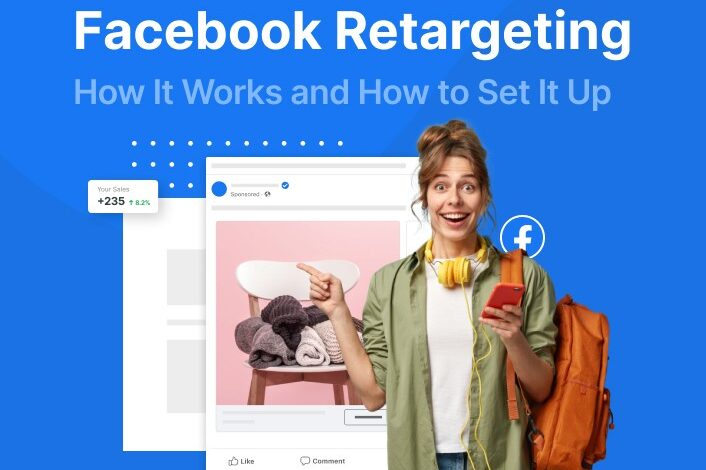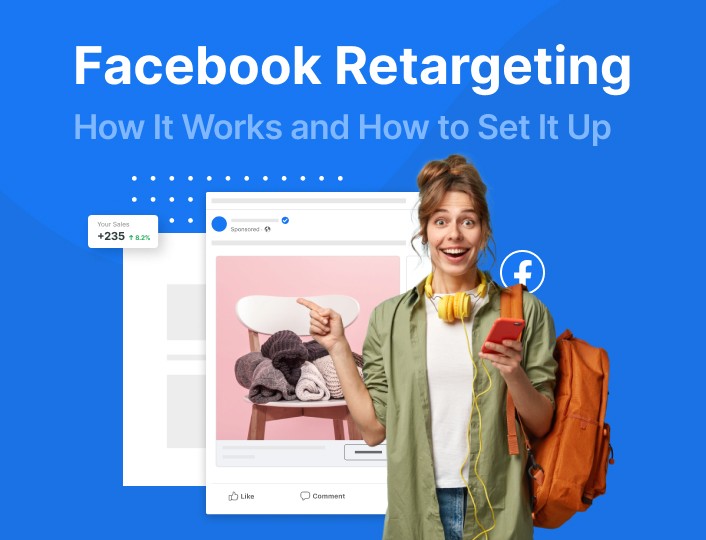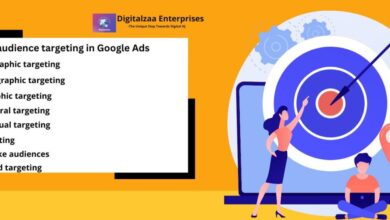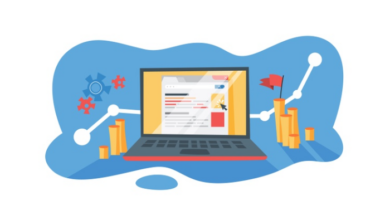
Facebook Retargeting Your Guide to Success
Facebook retargeting sets the stage for a powerful marketing strategy. It allows businesses to reconnect with website visitors who haven’t yet converted, driving targeted ads to those most likely to make a purchase. This guide dives deep into the strategies, tactics, and best practices behind effective Facebook retargeting campaigns.
This comprehensive guide explores everything from defining your target audience to crafting compelling ad creatives and optimizing your campaigns for maximum impact. We’ll also look at how to integrate Facebook retargeting with other marketing channels and navigate privacy concerns.
Introduction to Facebook Retargeting
Facebook retargeting is a powerful digital marketing strategy that allows businesses to re-engage users who have previously interacted with their website or social media pages. It leverages Facebook’s vast user base and sophisticated targeting capabilities to reach potential customers who have shown interest in your products or services. This targeted approach significantly increases the likelihood of conversion and maximizes the return on investment (ROI) of your advertising budget.This strategy hinges on the principle of reminding potential customers about your brand and offering them relevant products or services at the perfect moment in their journey.
By understanding user behavior and preferences, businesses can tailor their messaging to resonate with their specific needs and interests. This personalized approach often leads to higher conversion rates compared to broader advertising campaigns.
Different Types of Facebook Retargeting Campaigns
Facebook offers a variety of retargeting options, allowing businesses to tailor their campaigns to specific goals and audiences. Understanding these different types is crucial for creating effective campaigns.
- Website Visitors Retargeting: This type focuses on users who have visited your website but haven’t completed a desired action, like making a purchase or signing up for a newsletter. By re-engaging these potential customers, you can encourage them to complete the action and convert.
- Engagement Retargeting: This approach targets users who have interacted with your Facebook page or ads. This interaction could include liking posts, watching videos, or clicking on links. This type of retargeting is ideal for nurturing leads and building brand awareness.
- Custom Audiences Retargeting: This method allows you to import your existing customer data into Facebook. This enables you to retarget specific segments of your audience, such as past purchasers or subscribers to your email list, with tailored messaging. This allows for highly personalized communication.
- Lookalike Audiences Retargeting: This advanced technique uses your existing customer data to identify new potential customers who share similar characteristics. This allows you to expand your reach to people who are likely to be interested in your products or services.
Steps in Setting Up a Basic Retargeting Campaign
Setting up a retargeting campaign involves several key steps, ensuring that your strategy is well-defined and measurable.
- Define Your Goals: Clearly Artikel what you want to achieve with your retargeting campaign. This could include increasing sales, generating leads, or boosting brand awareness. Setting specific and measurable goals is crucial for evaluating the success of your campaign.
- Create a Pixel: A Facebook pixel is a small piece of code that tracks website activity. This code allows Facebook to identify users who have interacted with your website and create targeted advertising campaigns.
- Set Up Your Retargeting Audience: Define the criteria for your retargeting audience. This could include users who have visited specific pages, added items to their cart, or performed other actions on your website.
- Craft Compelling Ads: Design engaging ads that resonate with your target audience. Highlight the value proposition of your products or services and use compelling visuals and persuasive language.
- Monitor and Optimize: Regularly track the performance of your campaign and make adjustments as needed. Analyze key metrics such as click-through rates, conversion rates, and cost per acquisition to identify areas for improvement.
Benefits and Drawbacks of Facebook Retargeting
| Benefit | Drawback |
|---|---|
| Increased Conversion Rates: Retargeting helps remind users about your product or service, increasing the likelihood of conversion. | Potential for Annoying Users: If not implemented carefully, retargeting can lead to users feeling annoyed by repeated ads. |
| Targeted Advertising: Retargeting allows for highly targeted advertising campaigns, focusing on users who have already shown interest. | Requires a Well-Defined Strategy: Effective retargeting requires careful planning, including audience definition and ad creation. |
| Cost-Effective: Compared to broader advertising campaigns, retargeting can be more cost-effective due to the focus on potential customers who are already interested. | Competition: Many businesses utilize Facebook retargeting, creating competition for attention and conversions. |
| Measurable Results: Facebook provides detailed analytics to track the performance of your retargeting campaigns. | Limited Reach: Retargeting campaigns are focused on users who have already interacted with your brand, potentially limiting the overall reach of your message. |
Target Audience Definition and Segmentation
Precise audience definition is crucial for Facebook retargeting success. Knowing your ideal customer intimately allows you to craft highly targeted ads, increasing the likelihood of conversion. Without a clear understanding of who you’re trying to reach, your retargeting efforts may fall flat, wasting budget and resources. Effective segmentation strategies allow you to tailor messaging and creative to resonate specifically with different customer segments, driving higher engagement and conversion rates.Defining your ideal customer profile (ICP) is the cornerstone of successful retargeting.
This involves understanding their demographics, psychographics, behaviors, and pain points. By meticulously identifying your ICP, you can create retargeting campaigns that resonate deeply with your audience, leading to a more effective return on investment (ROI).
Defining Ideal Customer Profiles (ICPs)
Understanding your ideal customer profile (ICP) is paramount for effective retargeting. This involves a deep dive into the characteristics of your most valuable customers. Consider factors like demographics (age, location, gender), interests, online behavior (website activity, social media engagement), and purchasing history. Analyzing these elements helps you create tailored ad campaigns that speak directly to their needs and desires.
Facebook retargeting is a powerful tool, but sometimes you need to dig deeper. Understanding how customers interact with your brand beyond Facebook is key. For example, checking out google customer reviews can offer valuable insights into your brand perception. This feedback, coupled with your Facebook retargeting efforts, creates a more holistic approach to marketing.
Combining this data with insights about their motivations, pain points, and goals helps you create a more holistic view of your target audience, allowing you to craft more effective retargeting campaigns.
Facebook retargeting is a fantastic way to reconnect with potential customers who’ve shown interest in your products or services. But to truly maximize its impact, you need to understand how it fits into a broader marketing strategy, like outbound marketing. By integrating retargeting with targeted outbound marketing campaigns, you can significantly increase conversions and overall return on investment.
This approach leverages the power of Facebook retargeting by reminding potential customers of your offerings after they’ve interacted with your brand, thus keeping your company top-of-mind in their decision-making process. So, dive deep into the strategies of outbound marketing to understand how you can make retargeting even more effective.
Audience Segmentation Strategies on Facebook
Facebook offers several segmentation strategies to refine your retargeting campaigns. Understanding these strategies empowers you to pinpoint specific groups within your target audience. Segmenting your audience enables you to personalize your messaging, maximizing engagement and conversion rates.
- Demographic Segmentation: This involves dividing your audience based on factors like age, gender, location, education, and income. For example, targeting users in a specific age range who live in a particular region and have a certain level of education can significantly improve the relevance of your ads.
- Behavioral Segmentation: This focuses on how users interact with your business. Analyzing website behavior, such as page views, purchase history, and time spent on certain pages, allows you to understand user engagement patterns. Tailoring retargeting campaigns based on this behavior can improve conversion rates by addressing specific actions taken on your website.
- Interest-Based Segmentation: Facebook allows targeting users based on their expressed interests, hobbies, and pages they engage with. Identifying common interests within your target audience can help refine your ad copy and ensure it resonates with the specific group.
Identifying and Targeting Lookalike Audiences
Lookalike audiences are a powerful retargeting tool on Facebook. They expand your reach by identifying users who share similar characteristics with your existing customers. This allows you to potentially tap into a wider pool of potential customers with high conversion potential. A crucial aspect of this approach is the seed audience, which determines the scope of the lookalike audience.
Using your existing customer data as a foundation, Facebook identifies individuals with similar characteristics.
Different Audience Targeting Options
This table contrasts various audience targeting options on Facebook for retargeting, highlighting their strengths and weaknesses.
| Targeting Option | Description | Strengths | Weaknesses |
|---|---|---|---|
| Custom Audiences | Import your customer data (email lists, website visitors, app users) into Facebook. | High accuracy, directly targets known users, provides detailed data. | Requires importing customer data, can be time-consuming to build. |
| Lookalike Audiences | Identify users who share characteristics with your existing customers. | Expands reach, potentially identifies new customers with high conversion potential. | Reliance on seed audience quality, might not be suitable for all businesses. |
| Interest-Based Audiences | Target users based on their interests and pages they engage with. | Effective for broad targeting, can reach a wide audience. | Potential for lower conversion rates if not highly targeted, can be less precise than custom audiences. |
Ad Creative Strategies
Crafting compelling ad creatives is crucial for retargeting success. These ads need to re-engage past visitors, reminding them of your brand and product offerings. A well-designed ad creative can significantly boost click-through rates and conversions. Focus on showcasing value, highlighting unique selling propositions, and using strong calls to action.
Best Practices for Engaging Ad Creatives
Effective retargeting ads resonate with past site visitors by subtly reminding them of their previous interactions. These ads need to feel personalized and relevant to the individual’s past browsing history. Highlighting products or services previously viewed or actions taken is a powerful technique. Personalization increases the likelihood of capturing attention and driving conversions. Strong visuals, concise messaging, and a clear call to action are paramount.
Compelling Visuals and Copy Examples
Visuals play a significant role in capturing attention. Use high-quality images or videos showcasing your product’s features and benefits. For example, a retargeting ad for a clothing retailer could display an image of a customer wearing the item they previously viewed. In copy, highlight the value proposition and address specific needs. For example, instead of simply stating “Buy Now,” use a phrase like “Get 20% off your next purchase.”
A/B Testing for Optimization
A/B testing different ad variations is crucial for optimizing performance. Test different visuals, headlines, descriptions, and calls to action. Track metrics like click-through rates and conversion rates to identify what resonates best with your target audience. For instance, test variations of the same image with slightly different copy or vice versa. Analyzing the results of A/B tests helps refine ad creatives for maximum impact.
Different Ad Formats
Various ad formats are suitable for retargeting campaigns. Consider using image ads, video ads, carousel ads, or collection ads. Carousel ads, which allow multiple images and descriptions, are especially effective for showcasing a variety of product options. The optimal choice depends on the specific campaign goals and target audience. If you’re promoting a product with multiple features, a carousel ad could be a good fit.
Table of Ad Creative Elements and Impact on Conversions
| Ad Creative Element | Description | Impact on Conversions |
|---|---|---|
| Visuals | High-quality images or videos showcasing the product or service | Improved attention-grabbing and product recall, leading to higher click-through rates. |
| Copy | Concise and persuasive text that highlights value propositions and addresses specific needs. | Clear communication of benefits and a strong call to action can significantly improve conversion rates. |
| Call to Action (CTA) | Clear instructions prompting the user to take a desired action (e.g., “Shop Now,” “Learn More”). | Explicit instructions guide users toward desired actions, ultimately leading to higher conversions. |
| Ad Format | Different types of ads, like image ads, video ads, or carousel ads. | Appropriate ad formats help present products or services effectively, increasing the likelihood of user engagement. |
Campaign Optimization and Performance Tracking
Facebook retargeting campaigns, while powerful, require diligent monitoring and optimization for maximum ROI. Understanding key performance indicators (KPIs) and how to analyze campaign data is crucial for making informed adjustments and achieving your marketing goals. This section delves into the practical aspects of campaign optimization, empowering you to build robust and effective retargeting strategies.Effective retargeting hinges on the ability to measure, analyze, and adapt.
Facebook retargeting is a powerful tool for boosting website traffic, but the real magic happens when you pair it with a strong SEO strategy. Choosing the right website CMS is crucial for this; knowing the top 5 website CMS for SEO, like the top 5 website cms for seo , will help you create a user-friendly site that’s easily crawlable by search engines.
This ultimately leads to better visibility in search results, making your retargeting campaigns even more effective. It’s all about that perfect synergy.
A deep understanding of performance metrics allows for strategic pivots based on real-time insights, ensuring your budget is spent wisely and your campaigns are driving tangible results.
Key Performance Indicators (KPIs) for Retargeting
Tracking the right metrics is essential for evaluating retargeting campaign success. Several key performance indicators (KPIs) provide crucial insights into campaign performance.
- Click-Through Rate (CTR): The percentage of users who saw your ad and clicked on it. A high CTR indicates engaging ad copy and compelling visuals, resonating with your target audience. For example, a CTR of 2% suggests that for every 100 people who see your ad, 2 click through.
- Conversion Rate: The percentage of users who clicked your ad and completed a desired action (e.g., making a purchase, filling out a form). A high conversion rate indicates effective ad targeting and persuasive calls to action. For example, if 10 people click on an ad and 3 make a purchase, the conversion rate is 30%.
- Cost Per Click (CPC): The amount you pay for each click on your ad. Lower CPCs are generally desirable, signifying efficient ad spending and effective targeting.
- Cost Per Acquisition (CPA): The amount you spend to acquire a new customer. A lower CPA indicates successful campaign management and effective lead generation.
- Return on Ad Spend (ROAS): The revenue generated for every dollar spent on advertising. A higher ROAS demonstrates a profitable campaign.
Analyzing and Interpreting Campaign Data
Understanding campaign data goes beyond simply observing numbers. Analyzing trends and patterns within the data provides actionable insights for improvement. Detailed analysis can reveal insights into audience engagement, ad performance, and campaign effectiveness.
- Identify Trends: Examine data over time to spot patterns in CTR, conversion rates, and other KPIs. A sudden drop in CTR might suggest a problem with your ad creatives or targeting. Regular monitoring helps you identify these issues promptly.
- Segmentation Analysis: Break down data by audience segments (e.g., demographics, interests) to understand which segments are most responsive to your ads. This can inform targeting adjustments to maximize efficiency.
- A/B Testing: Test different ad creatives, copy, and targeting parameters to determine what resonates best with your audience. Use the results to refine your strategy and improve performance.
Adjusting Campaign Settings
Campaign performance analysis should lead to strategic adjustments in campaign settings. Use data-driven decisions to optimize your campaigns.
- Adjusting Targeting: If a specific segment isn’t converting, consider refining your targeting parameters to exclude less responsive demographics or interests. This can significantly improve your campaign’s overall performance.
- Modifying Ad Creatives: If CTR is low, A/B test different ad creatives (images, text, calls to action) to find what resonates best with your target audience. Testing various formats can lead to noticeable improvements.
- Optimizing Bidding Strategies: Consider adjusting bidding strategies (e.g., manual, automatic) to align with your campaign goals and budget. Fine-tuning these strategies ensures optimal ad placement and improved ROI.
Identifying and Eliminating Underperforming Ad Sets
Regularly review ad set performance and identify underperforming ad sets. Eliminating these underperforming ad sets can free up budget and improve overall campaign performance.
- Performance Benchmarks: Establish clear performance benchmarks (e.g., minimum CTR, conversion rate) for each ad set. Ad sets falling below these benchmarks can be flagged for review and potential elimination.
- Identifying Ineffective Targeting: Underperforming ad sets often indicate issues with targeting. Analyze the audience demographics and interests associated with these sets to identify areas for improvement.
Continuous Optimization Strategies
Regularly monitoring and adapting your Facebook retargeting campaigns is crucial for long-term success. Continuous optimization strategies ensure sustained high performance.
- Establish a Routine: Set up a regular schedule for reviewing campaign performance (e.g., weekly or bi-weekly). Consistency ensures that potential issues are addressed promptly.
- Stay Updated: Facebook’s algorithm and best practices are constantly evolving. Staying informed about updates and best practices allows for incorporating new strategies into your campaign.
Building a Performance Dashboard
A comprehensive dashboard visually represents your campaign’s performance. Creating a dashboard centralizes all relevant data for easy monitoring and analysis.
- Key Metrics: Include key metrics (CTR, conversion rate, CPA) on the dashboard for at-a-glance performance assessment.
- Visualizations: Utilize charts and graphs to represent data trends over time. Visualizations make identifying patterns and trends easier.
Advanced Retargeting Techniques
Beyond basic retargeting, advanced strategies unlock deeper engagement and conversion opportunities. These techniques leverage more sophisticated data points and user behavior analysis to deliver highly personalized and relevant ads, ultimately driving higher ROI. By tailoring ads to individual user needs and preferences, businesses can create more impactful campaigns.Advanced retargeting goes beyond simply showing ads to those who have previously visited a website.
It involves understanding user journeys, recognizing patterns, and responding dynamically to their evolving needs. This creates more effective and engaging advertising experiences that improve the customer experience and encourage conversions.
Dynamic Product Ads in Retargeting
Dynamic product ads (DPAs) are a powerful retargeting tool. They automatically display products a user has viewed or interacted with on a website. This personalized approach significantly improves ad relevance. By showcasing items the user has expressed interest in, the ads become highly targeted, increasing the likelihood of a purchase. For example, if a user browses several laptops on a retailer’s website but doesn’t buy one, a DPA could later show them targeted ads for those specific laptops.
This significantly increases the chances of conversion.
Retargeting Based on Website Behavior
Analyzing website behavior provides valuable insights for personalized retargeting. Identifying specific actions, like adding items to a cart or abandoning a purchase, allows for tailored ad campaigns. For instance, a user who adds several items to a shopping cart but doesn’t complete the purchase can be retargeted with ads highlighting the benefits of completing the purchase or offering discounts.
Remarketing for Abandoned Carts
Abandoned carts represent a significant opportunity for lost sales. Retargeting these users with compelling ads can encourage them to complete their purchases. These ads can highlight the items in the abandoned cart, offer a discount, or provide a sense of urgency. For example, a user adds a specific gaming headset to their cart but doesn’t complete the purchase.
A retargeting ad can reappear on their feed with a limited-time discount for the headset.
Creating Personalized Experiences with Retargeting Ads
Personalization is key to successful retargeting. Utilizing data like user demographics, browsing history, and past purchase behavior allows for the creation of highly customized ads. This approach ensures that ads resonate with individual preferences, fostering stronger engagement and ultimately driving conversions. For instance, a user frequently purchases outdoor gear. Retargeting ads could feature new hiking boots or camping equipment that align with their past purchases.
Advanced Retargeting Tactics and Benefits
| Retargeting Tactic | Benefits |
|---|---|
| Dynamic Product Ads | Increased ad relevance, higher click-through rates, improved conversion rates |
| Website Behavior Analysis | Personalized ad experiences, improved customer engagement, targeted promotions |
| Abandoned Cart Remarketing | Recovery of lost sales, increased conversion rates from abandoned carts, improved customer retention |
| Personalized Experiences | Enhanced user experience, increased brand loyalty, higher customer lifetime value |
Retargeting and Privacy Concerns
Retargeting campaigns, while powerful for boosting conversions, raise significant ethical and legal concerns, particularly regarding user privacy. Understanding and addressing these concerns is crucial for businesses to operate ethically and avoid potential legal repercussions. This section delves into the implications of privacy regulations, best practices for compliance, and ethical considerations in retargeting.Privacy regulations, like GDPR and CCPA, mandate that businesses respect user data and obtain informed consent before collecting and using personal information.
These regulations impact retargeting by requiring transparency about how data is collected and used, and by imposing restrictions on data processing. Navigating these regulations requires a nuanced approach to retargeting, ensuring compliance while maximizing campaign effectiveness.
Implications of Privacy Regulations on Retargeting, Facebook retargeting
Privacy regulations, like GDPR and CCPA, directly impact retargeting strategies. These regulations demand businesses obtain explicit consent from users for data collection and usage. Failure to comply can lead to hefty fines and reputational damage. For example, a company using retargeting ads without user consent could face penalties under GDPR or CCPA.
Best Practices for Adhering to Privacy Regulations
Implementing retargeting ethically and legally necessitates careful adherence to privacy regulations. Transparency in data collection and usage is paramount. Businesses should clearly inform users about how their data is collected, used, and protected, obtaining explicit consent for retargeting. Providing users with control over their data, such as opt-out options, is also crucial. Using clear and concise language in privacy policies and consent forms ensures users understand the implications of data usage for retargeting.
For example, providing users with granular control over the types of ads they see can be a good practice.
Examples of Addressing Privacy Concerns
Many businesses are proactively addressing privacy concerns related to retargeting. Some companies are implementing granular consent mechanisms, allowing users to opt-in or opt-out of specific retargeting categories. Others are using anonymized or pseudonymous data to the extent possible. A prime example is the use of hashed email addresses, allowing targeted advertising without revealing the user’s precise identity.
Another example is emphasizing transparency in privacy policies, explicitly outlining the retargeting practices.
Strategies for Obtaining Informed Consent
Obtaining informed consent for retargeting requires a multi-faceted approach. Clear and concise language in privacy policies and consent forms is essential. Providing users with explicit choices about their data usage, like checkboxes for different retargeting categories, is a key aspect. Implementing a robust opt-out mechanism is vital, enabling users to easily prevent retargeting at any time. Additionally, making the process of providing consent easy and accessible is critical for effective implementation.
For instance, using a clear and prominent consent banner on the website with a user-friendly opt-in/opt-out mechanism is a practical solution.
Ethical Considerations in Retargeting Campaigns
Ethical considerations are crucial for effective and responsible retargeting. Respecting user privacy is paramount. Avoidance of manipulative or misleading practices, such as targeting users with highly sensitive ads based on their browsing history, is important. Prioritizing user experience and transparency in all interactions is key. Businesses should avoid retargeting with content that exploits or takes advantage of vulnerable users.
For instance, a company targeting users with ads for expensive products based on their past searches for financial aid could be seen as unethical.
Potential Legal Issues and Solutions for Retargeting
| Legal Issue | Solution |
|---|---|
| Non-compliance with GDPR or CCPA | Implement robust data privacy policies, obtain explicit consent, and establish clear opt-out mechanisms. |
| Misleading or manipulative retargeting tactics | Ensure transparency in data collection and usage, avoid targeting sensitive information, and prioritize user experience. |
| Data breaches related to retargeting data | Implement robust security measures, regularly audit data protection practices, and have a comprehensive incident response plan. |
| Targeting vulnerable users with inappropriate ads | Avoid retargeting based on sensitive information or potentially exploitative criteria, and prioritize responsible advertising practices. |
Integration with Other Marketing Channels

Facebook retargeting isn’t an island; it thrives best when integrated into a broader, multi-channel marketing strategy. Effective retargeting campaigns leverage the strengths of other channels like email marketing, search engine marketing (SEM), and content marketing to create a more cohesive and impactful customer journey. By synchronizing your efforts, you can significantly enhance the effectiveness of your campaigns and achieve better results.Cross-channel campaign coordination is crucial for optimizing the customer experience and maximizing return on investment (ROI).
This involves carefully aligning messaging and targeting across different platforms to maintain a consistent brand voice and deliver a unified customer experience.
Strategies for Cross-Channel Campaign Coordination
A well-coordinated strategy ensures that every touchpoint in the customer journey reinforces the message and drives the desired action. Key elements include:
- Shared Data and Targeting: Utilizing a unified customer database allows for consistent and targeted messaging across platforms. This ensures that prospects and customers receive relevant content based on their past interactions and preferences.
- Consistent Messaging: Maintaining a consistent brand voice and messaging across all channels fosters trust and recognition. This includes matching visual elements, tone, and key selling points to create a unified brand experience.
- Campaign Tracking and Analysis: Integrating tracking across all channels allows for detailed analysis of customer journeys. This enables marketers to identify the most effective touchpoints and optimize campaigns for maximum impact.
Retargeting with Email Marketing
Email marketing provides a direct line of communication with your audience. Integrating retargeting with email allows for a powerful combination of broad reach and personalized follow-up.
- Targeted Email Sequences: Identify users who have interacted with your Facebook ads but haven’t converted. Create targeted email sequences that nurture these leads, providing valuable content and offers to encourage conversions.
- Personalized Email Content: Use the data collected from Facebook retargeting to personalize email content. This could include highlighting specific products or services viewed on Facebook, referencing past interactions, or offering exclusive discounts.
- Dynamic Content in Emails: Use Facebook retargeting data to dynamically insert specific product information into emails. This creates a seamless experience, bridging the gap between online and offline interactions.
Retargeting and Search Engine Marketing (SEM)
Retargeting complements search engine marketing (SEM) by reaching users who have shown interest in your products or services, but didn’t convert on the initial search.
- Targeting Previously Engaged Users: Use SEM to reach users actively searching for products or services similar to yours. Retargeting can then target those who visited your website or showed interest in specific products, but didn’t complete a purchase.
- Creating Compelling Ad Copy: Highlight specific products or services viewed by users during their previous visit to your site. This reinforces the relevance of your offerings and encourages conversions.
- Example: A user searches for “running shoes” on Google. If they visit a shoe retailer’s website but don’t buy, retargeting ads can reappear on Facebook showcasing the specific running shoes they viewed.
Enhancing the Marketing Funnel
Retargeting effectively enhances the customer journey by targeting users at different stages of the marketing funnel.
- Top of Funnel: Retargeting can capture initial interest and awareness by re-engaging users who visited your website or engaged with your social media content.
- Middle of Funnel: Retargeting nurtures leads by reminding them of products or services they expressed interest in, driving them toward conversion.
- Bottom of Funnel: Retargeting can re-engage users who abandoned their shopping carts or failed to complete a purchase, encouraging them to finalize their transactions.
Synergistic Effects of Combining Facebook Retargeting with Other Channels
| Channel | Synergistic Effect |
|---|---|
| Facebook Retargeting | Reaches users who have previously interacted with the brand, increasing conversion rates. |
| Email Marketing | Provides personalized follow-up and nurtures leads who haven’t converted, boosting conversion rates and customer lifetime value. |
| Search Engine Marketing (SEM) | Targets users actively searching for products or services, driving qualified traffic and generating leads. |
Final Thoughts: Facebook Retargeting

In conclusion, mastering Facebook retargeting empowers businesses to cultivate a stronger online presence and boost conversions. By understanding the key strategies and staying updated on best practices, you can leverage this powerful tool to enhance your marketing efforts and achieve significant results. The intricacies of Facebook retargeting, while complex, are ultimately manageable and highly rewarding for businesses who take the time to learn and implement the right strategies.




